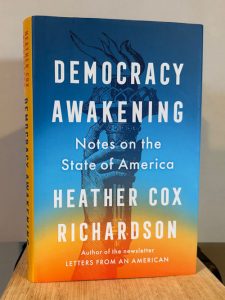Continuing my fairly detailed summary notes of this book. The second part of this book is about the ascendance of Trump, finishing with the “Big Lie” that the 2020 election was stolen from him. The third part of the looks back at the roots of America and wonders how we can now reclaim its ideals from the authoritarians and autocrats.
Part 2: The Authoritarian Experiment
Ch11, A Snapshot of America, p83
Trump announced his campaign for president on June 16, 2015. He came from reality TV, a show the producers thought was a joke, beginning in 2004. He was more image than substance. p84.7:
Establishment Republicans who wanted an end to government regulation of business and taxes had courted racists, sexists, and religious zealots to stay in power but had no plans actually to give in to extremist demands, which would turn off mainstream voters. Trump stripped the cover off this sleight of hand, offering to give the extremist base a hierarchical world in which they dominated women as well as their Black and Brown neighbors.
Trump promised a return to the mythological world in which his followers called the shots, and only he could lead the way. He made lots of promises and misstated lots of facts. He reused Reagan’s slogan. He was the best at everything.
His and Steve Bannon’s view of returning to government led by wealthy white males, cutting the US off from the rest of the world, putting Christianity at the center, appealed to many, especially evangelicals, who loved the idea of removing recognition of the rights of minorities, women, and LGBTQ people.
Not all Republicans agreed; the American state stabilized the global economy. But it fit well with Putin’s plan. And Russians help smear Hillary Clinton.
Trump held 232 campaign rallies, attacking the ‘lying media’, immigrants, and so on; promising a wall that Mexico would pay for and to ban Muslims; and to ‘drain the swamp’ of Washington. Hillary provided detailed policy papers, while Trump chanted ‘lock her up’. His techniques were similar to Joseph McCarthy’s. The campaign used social media, compiling Facebook profiles. Then James Comey reopened an investigation into Hillary’s emails, and swing voters turned against her. Trump lost the popular vote but won the electoral college. Comey found nothing. Trump ranted about American “carnage.”
Ch12, A Shocking Event, p93
American finally had a president with the power to destroy the government. Many Republicans were more interested in the kind of oligarchy that ruled in the 1920s and before. Trump went straight for authoritarianism. He began immediately, when he insisted his inauguration crowd was bigger than Obama’s. He knew he could flatly lie, and the press would cover it. Kellyanne Conway took refuge in “alternative facts”. This rhetorical strategy is called gaslighting. This leads to blackmail. Bannon called this “flooding the zone with sh*t.” It destabilizes the population.
The Washington press was unprepared. Women responded with the largest single-day demonstration in world history, wearing ‘pussy’ hats. A week later Trump banned travel from primarily Muslim countries. The plan came from Stephen Miller and Stephen Bannon. Trump fired the acting attorney general for pushing back. Their next idea was to separate children from parents among refugees at the border. Miller and allies avoided officials who wouldn’t cooperate and found ones that did, even if they were less talented. Lawyers around the country sprang up to defend the refugees…
Ch13, Russia, Russia, Russia, p101
Laws had long been in place to dissuade foreign interference in elections, but in 2017 a report found that Russia had interfered in the 2016 election, and the Trump campaign had played along. Russian interference began decades before. Struggle for Ukraine began in the early 2000s. Putin consulted Paul Manafort for help; he specialized in demonizing opponents. Manafort eventually became Trump’s campaign chair. At one point Trump invited Russia to hack Hillary’s computer system. Russian operative flooded social media with disinformation, spreading lies about Clinton. And to drive wedges among Americans, via fake accounts. Obama tried to warn people about Russian interference; Mitch McConnell downplayed it. Then Trump won. Comey and the FBI investigated promises Michael Flynn made to the Russians; Trump fired Comey. Trump fought to reverse reality, claiming himself as victim. He accused Democrats of being part of a “deep state” conspiring against him. Trump fired more people; hired others to lie for him, Barr about the Mueller report. 107m. His supporters believed the lies. Democrats became the enemy. Eventually, 34 people were indicted or pleaded guilty for the 2016 election and cover-up; Trump pardoned several before he left office. Trump had successfully sold his own narrative over the truth. Republicans supported him or stayed silent.
Part 3: Reclaiming America
Ch21, What Is America?, p163
What are the principles upon which the nation was founded? The Founders threw off the European tradition that some men were deemed better than others, and destined to rule. Still, they erred in only considering white men, not non-whites, not women. Some of them owned slaves. So their equality depended on built-in inequality. Was it a sham? In 2019 NYT launched its Project 1619, that suggested it was. That the essence of America was the slave trade. Trump responded with a 1776 Commission, that cited only the Founders, and created the kind of historical myth that authoritarians require, declaring it a divine plan. 165b. They demonstrated that point. It entailed “defining the powerless as inferiors, either criminals or weak-minded people unable to think and act for themselves.” 166m. Thus the Jan 6th attackers, before that Jim Crow, and indigenous Americans on reservations. Hitler looked to those policies for advice. The other story of America is the constant struggle to actually achieve freedom for all. Many examples of organizers and spokesmen across the centuries. Is it possible to achieve this?
Ch22, Declaring Independence, p171
Details of the many groups and communities… How the colonists decided they had a right to govern themselves. The Stamp Act of 1765. Sons of Liberty. John Adams, Samuel Adams. British troops came to Boston in 1768… The Boston Massacre, 1770. Monopoly by the East India Company for tea sales in the colonies. Boston Tea Party, Dec 1773. Minute Men. Paul Revere. Second Continental Congress. The King declared the colonies in rebellion. Jan 1776, Thomas Pained published Common Sense, which became the bestselling book in American history. Various declarations were written. Congress appointed a committee to draft a formal Declaration. The final document was adopted by Congress on July 4, 1776. With its ‘self-evident’ propositions.
Ch23, The Constitution, p179
Next, how would this government actually work? There was a false start in the Articles of Confederation. These policies stood for about a decade, and began not working. The Constitution was written in 1786. With its ‘no religious test’. Details. The two houses; the census. And how enslaved American counted only three fifths of a person. How would voters know which candidate was best? There were no media in those days, and people didn’t travel. Thus ‘electors’ and the electoral college. Then the judicial branch. The Bill of Rights 184.7. But the Framers did not foresee the rise of political parties. The Southerners opposed Washington’s policies. Fair representation was eliminated, in the way all of a state’s electoral votes went to whoever had the majority. Also, to keep power politicians would add new, sparsely populated states to the Union—six states in 1889 and 1890. Nor did they foresee vast cities.
Ch24, Expanding Democracy, p187
Those who were not white men complained they had been left out. So there was a Declaration of Sentiments. But one judge insisted the idea of liberty “could not possibly mean the destruction of men’s patriarchal authority.” The Cherokees insisted on their own laws. Then there were poor white men. The Southerners began to argue that democracy was about states, not the federal government. Manifest Destiny. And so on. Abraham Lincoln disagreed, p193, complaining about “the arguments that kings have made for enslaving the people in all ages of the world.”
Ch25, Mudsills or Men, p195
By 1860 the wealthiest southerners were the nation’s richest people. They insisted their system, with their slaves, was the perfect one. Their great truth was that white men were a superior race. Most people were ‘mudsills’, timbers that supported houses above. Southerners saw themselves modern day British aristocrats. As northern leaders sought to limit the spread of slavery, southern white leaders insisted this was an attack on democracy, by which they meant states’ rights. The Dred Scott decision affirmed the inferiority of blacks and rights of slave-holders. Meanwhile, the Erie Canal enabled poor whites to move west. Lincoln insisted on equality for everyone. To the point of insisting that government action was authorized to maintain those rights. Lincoln was nominated; Republicans tied equality before the law to the principles of the Founders. Southern states began removed themselves from the Union.
Ch26, Of the People, by the People, for the People, p203
Lincoln’s Republican party reorganized the government to work for ordinary men – not simply protect the property of wealthy slaveholders. In March 1861 the seven seceding states launched the Civil War, at Fort Sumter. To fund the war, Republicans in the north invented national taxation. Americans liked them, had them raised. M/w came the Homestead Act, state universities, the Dept of Agriculture, the Pacific Railway Act. In 1863, after two years, the US was not doing well. Lincoln gave his speech at Gettysburg. In 1865 the Thirteenth Amendment abolished slavery. The southerners were not happy; Booth assassinated Lincoln. Johnson, more sympathetic to the South, offered amnesty to former Confederates. And pardoned many. Thus emboldened, southerners passed laws against blacks, and launched race riots. What were northerners to do? Not let the south rebuild. Congress passed the fourteenth amendment, reversing Dred Scott, and prohibiting states from discrimination against anyone. 1868. And in 1870, the Department of Justice. And the Fifteenth Amendment, guaranteeing Black men the right to vote.
Ch27, America Renewed, p211
These two new amendments created the possibility of a multicultural and multigendered democracy. But it didn’t remove the assumption of the patriarchal system. Suffragists began to assert their rights, in 1870. Susan B. Anthony was convicted of the crime of voting. In 1875 the Supreme Court agreed that women were citizens, but not necessarily having the right to vote. Soon whites were suppressing black votes. The Chinese Exclusion Act was passed in 1882; in 1884, the Court rules that Indians were not citizens. Various means of restricting black votes were passed.
The disenfranchised began to write, with Horatio Alger in 1868 and others emphasizing the value of hard work, and education. Booker T. Washington in 1901. Also women. They became more than half of all high school graduates. And so on… Indigenous Americans sued for their rights. 1882, Labor Day. Fraternal organizations formed. Those excluded for equality kept the idea of American democracy alive.
Ch28, A Progressive America, p221
By the late 19th century lots of white reactionaries abandoned the ideals of the Declaration of Independence. They argued that Black voters were trying to redistribute wealth from hardworking whites, and that this was socialism. And they wanted governments not to interfere with running their businesses. Carnegie. Never mind wealth inequality. The wealthy built libraries and concert halls and universities. By the 1880s, the industrialists were the heroes, and they controlled Congress. Yet the workers were poor, and worked in dangerous conditions. Republicans said addressing their needs was un-American. Harrison won the electoral college and declared his a businessman’s administration. They added six new states in 1889 and 1890, 224.3. But in the 1890s a new movement began, in the west. An Alliance movement. They proposed the direct election of senators. The Alliances won several states in 1890. They became the People’s Party, or Populists, in 1892. They returned Cleveland to the White House. Then came the Spanish-American War. With Theodore Roosevelt; then came the rebranding of the American cowboy. Republicans still favored the wealthy. When Roosevelt came into the White House, he expanded the meaning of liberalism, 228b. It was bipartisan, for a while.
In the early years of the twentieth century, progressive in both parties regulated business to stop corrupt industrialists from increasing their profits by adulterating milk with formaldehyde and painting candies with lead paint, for example; cleaned up the sewage systems and tenements in cities; protected public lands; invested in public health and education; raised taxes; and called for universal health insurance.
Ch29, The Road to the New Deal, p231
In 1909 the NAACP formed. This time it was the Democratic Party that helped expand the concept of liberal democracy. Reacting against southern extremists, they turned their focus to the north, embracing the multicultural themes of the big northern cities. These were the ‘New Democrats’. Along the way were the Mugwumps, Tammany Hall, improved working conditions, expanding the New Deal liberal consensus. The GI Bill brought hundreds of thousands into the workforce. Incomes doubled from 1945 to 1970. Single family homes, TV, cars, public education, became the norm. Marginal tax rates were high – 91% for the highest incomes.
Ch30, Democracy Awakening, p237
The New Deal established the liberal consensus, but it took time to expand rights to minorities. Foes of the liberal consensus have been fighting it since the 1980s. Civil rights came in the 50s and 60s. “Although southern white men passionately defended their right to rule over their Black neighbors through state legislation…” 238.2. Johnson signed the Civil Rights Act of 1964. His vision was of a Great Society. Republicans were against it. It included the 1965 Voting Rights Act, Medicare, Medicaid. Product warnings to protect consumers. The National Foundation for the Arts, and Humanities. In 1969, NPR. Poverty reduced from 1960 to 1969. Women in the work force expanded. Women gained rights to contraception and abortion. Opponents of all this won seats in the house and senate. But these trends made it to mass entertainment: All in the Family, and others, on TV. Nixon, who tried to unwind the liberal consensus, had to resign. But then came Reagan, echoing Nixon, who won with 50% of the vote, by saying government *was* the problem.
Conclusion: Reclaiming Our Country, p245
Carter warned in 1981 that the national interest is not the sum of individual or special interests. The common good is our common interest.
And now here we are. Reagan arrived, and the dismantling of the liberal consensus began. Republicans blamed immoral minorities and women for America’s problems. After decades, Trump became president. Biden followed, warning about authoritarianism. Especially after Jan 6, 2021. In his first two years, Biden managed to pass historical legislation that echoed that of FDR and LBJ. A few Republicans supported these measures, in 2021 and 2022. He rejoined international alliances like WHO. In Feb 2022, Putin invaded Ukraine. Notions about the efficiency and morality of Putin autocracy were discredited, 249.
Yet Trumpism carried on. They denied the election; they overturned Roe v. Wade. They went on to challenge all the liberal consensus ideas put in place since the 1930s. DeSantis. They perpetuated the myth that American history was rooted in some pure past that their opponents were destroying. CRT. Don’t make white people feel uncomfortable. Book banning.
But American democracy is based not on land or religion or race, but rather the concept of human equality. This is the history we need to reclaim. That’s what the Founders intended. The idea has been challenged ever since. 252. Lincoln recognized the struggle as that between common humanity and the divine right of kings. The principle of tyranny. Those who defend such principles are not conservatives, but radicals. But Lincoln couldn’t root out the hierarchical strand of our history, and there were always more would-be autocrats.
\\
Closing thoughts in a bit.






